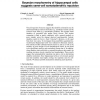Free Online Productivity Tools
i2Speak
i2Symbol
i2OCR
iTex2Img
iWeb2Print
iWeb2Shot
i2Type
iPdf2Split
iPdf2Merge
i2Bopomofo
i2Arabic
i2Style
i2Image
i2PDF
iLatex2Rtf
Sci2ools
NIPS
2001
2001
Bayesian morphometry of hippocampal cells suggests same-cell somatodendritic repulsion
Visual inspection of neurons suggests that dendritic orientation may be determined both by internal constraints (e.g. membrane tension) and by external vector fields (e.g. neurotrophic gradients). For example, basal dendrites of pyramidal cells appear nicely fan-out. This regular orientation is hard to justify completely with a general tendency to grow straight, given the zigzags observed experimentally. Instead, dendrites could (A) favor a fixed ("external") direction, or (B) repel from their own soma. To investigate these possibilities quantitatively, reconstructed hippocampal cells were subjected to Bayesian analysis. The statistical model combined linearly factors A and B, as well as the tendency to grow straight. For all morphological classes, B was found to be significantly positive and consistently greater than A. In addition, when dendrites were artificially re-oriented according to this model, the resulting structures closely resembled real morphologies. These resul...
| Added | 31 Oct 2010 |
| Updated | 31 Oct 2010 |
| Type | Conference |
| Year | 2001 |
| Where | NIPS |
| Authors | Giorgio A. Ascoli, Alexei V. Samsonovich |
Comments (0)

